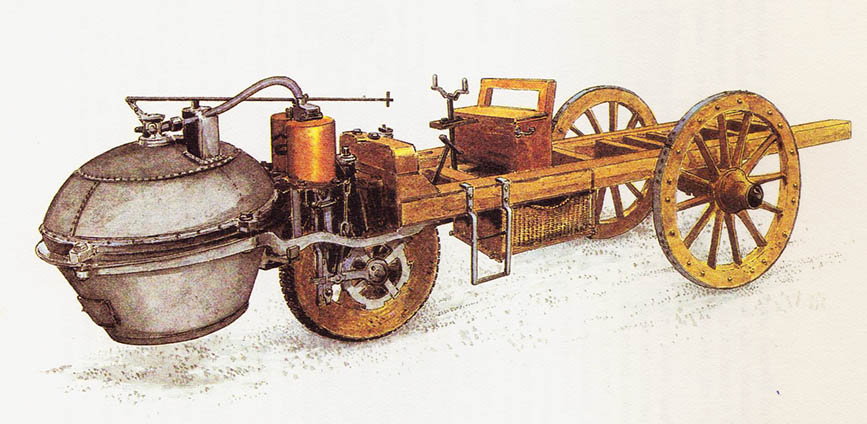COOKING – 1770 year
Manufacturer: N. J. Cugno, Paris, France
In Lorraine, St. 1725 r. Nicolas Joseph Cugnot was born, who from an early age promised to be a promising inventor and rationalizer. Not having adequate financial resources for his experiments, He entered the military service and, as a captain of the French army, made many valuable inventions, some of which have survived to this day. The most interesting thing about Cugnota was the steam engine. He wondered about using it to move the vehicle, and about it, how to reduce its weight, and raise power. W 1764 r. the French Minister of War entrusted him with the production of a steam artillery tractor. Cugnot designed a small vehicle model and in 1769 r. demonstrated it in Paris.

Cugnot's vehicle developed a constant cruising speed 4,5 km/h, but only by 12 minutes, for there was enough water and steam. Then the boiler had to be refilled with water, make a fire on the ground beneath him, wait, until steam has formed and then only continue the 12-minute drive again. The vehicle, despite its shortcomings, delighted the Minister of War so much, that he immediately commissioned Cugnot to build a second - improved and larger one.
In day 22 April 1770 r. the new vehicle has undergone numerous tests in the presence of official visitors and military experts. Driving speed did not exceed 4 km/h, but the boiler already had its own hearth. The two-cylinder single-stage steam engine was located above the front wheel. The bronze cylinders had a diameter 2325 mm, a stroke of the piston 378 mm. Movement was transferred from the piston rod to the front wheel via a ratchet. Reverse gear was engaged by the inclination of the ratchet.
During the demonstration of the vehicle, everything went well up to the point of, when the steering mechanism jammed and the vehicle crashed into a wall, smashing it to pieces. The vehicle emerged from the collision without damage, where it turned out, that it is an excellent combat vehicle. However, luck turned away from the inventor. Resigned and completely forgotten, Cugnot died in 1 804 r. in Brussels.
A fire was lit under the boiler for the last time, so that the vehicle can go from the arsenal to the Conservatoire Nationale des Arts et Metiers in Paris, where we can now admire him.